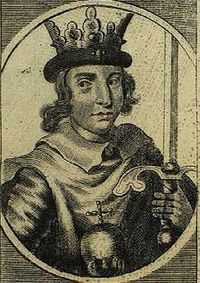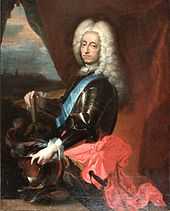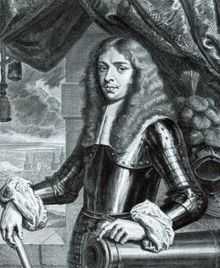Duke of Schleswig
The following list is a list of jarls and dukes, who ruled over Schleswig respectively Southern Jutland (Sønderjylland).
First jarls/dukes
| Picture |
Reign |
Name |
|
1080–1095 |
Olaf I, jarl (earl) of Jutland, since 1086 king of Denmark |
|
1095–1120 |
vacant |
|
1120–1131 |
Canute Lavard (Knud Lavard), titled dux Daciae[1] (i.e. Duke of Denmark) |
|
1131–1134 |
Magnus |
|
1134-ca. 1152 |
vacant |
|
ca. 1152–1154 |
Valdemar I the Great (Valdemar 1.), titled dux Daciae[1] (i.e. Duke of Denmark), also king of Denmark |
|
ca. 1152–1170 |
vacant |
|
ca. 1170–1173 |
Christopher of Jutland (illegitimate son of the precedent), titled dux Iuciae[1] (i.e. Duke of Jutland) |
|
1173–1183 |
vacant |
|
1183–1216 |
Valdemar II (Valdemar 2.), titled dux slesvicensis[1] (i.e. Sleswickian duke), represented by the regent Bishop Valdemar Knudsen (1182–1193), Valdemar II became Danish king in 1202 |
|
1209–1216 |
Valdemar the Young, son of the precedent, minor co-duke, also Danish co-king (1218–1231, d. 1231) |
|
1216–1232 |
Eric Valdemarsøn, minor duke, also Danish king as Eric IV (1241–1250) |
|
Years as given here according to Esben Albrectsen.[2]
Abelslægten (1232–1326)
| Portrait |
Reign |
Name |
|
1232–1252 |
Abel, king of Denmark (1250–52) |
|
1254–1257 |
Valdemar III |
|
1260–1272 |
Eric I |
|
1272–1283 |
vacant |
|
1283–1312 |
Valdemar IV (Valdemar 4. af Sønderjylland) |
|
1312–1325 |
Eric II |
|
1325–1326 |
Valdemar V, as Valdemar III Danish king |
|
House of Schauenburg (1326–1330)
| Portrait |
Reign |
Name |
|
1326–1330 |
Gerhard I the Great (Gerhard den kullede greve), as Gerhard III, Count of Holstein-Rendsborg |
|
Abelslægten (1330–1375)
| Portrait |
Reign |
Name |
|
1330–1364 |
Valdemar V., as Valdemar III. king of Denmark |
|
1364–1375 |
Henry |
|
House of Schauenburg (1375–1459)
| Portrait |
Reign |
Name |
|
1375–1381/1384 |
Henry the Iron (Danish: Henrik Jern) and his brother Nicholas (Danish: Klaus, joint rule) |
|
1375–1386 |
Nicholas and Henry II the Iron in joint rule till 1381/1384 |
|
1386–1404 |
Gerhard II, Duke of Southern Jutland (Sønderjylland), as Gerhard VI, Count of Holstein-Rendsborg |
|
1404–1427 |
Henry III, Count of Holstein-Rendsburg as Henry IV also, as duke under tutelage of the Danish crown until 1414, then the crown disputed his claim to dukedom, he was killed in action warring for his claim |
|
1427/40-1459 |
Adolf I, also Count of Holstein-Rendsburg as Adolf VIII, younger brother of Henry, Denmark denied his claim to dukedom until 1440 |
|
1427–1433 |
Gerhard III, co-ruler, also Count of Holstein-Rendsburg as Gerhard VII, younger brother of Adolf VIII, during his lifetime, the claim to dukedom remained disputed by the Danish crown |
|
House of Oldenburg (1460–1544)
Co-ruling dukes of the Houses of Oldenburg, Gottorp and Haderslev
|
|
|
House of Oldenburg (1544–1580)
|
| Portrait |
Reign |
Name |
|
1523–1559 |
Christian III – with his brothers Adolf and John II |
|
1559–1588 |
Frederick II (Frederik 2.) |
|
House of Schleswig-Holstein-Haderslev
|
| Portrait |
Reign |
Name |
|
1544–1580 |
John II the Elder – with his brothers Adolf and Christian, and then the latter's son Frederick.
|
| In 1580 Frederick II and Adolf divided John's share among each other. |
|
House of Schleswig-Holstein-Gottorp (1544–1580)
|
| Portrait |
Reign |
Name |
|
1544–1586 |
Adolf – with his brothers John II and Christian and then the latter's son Danish Frederick II
|
|
Co-ruling dukes of the Houses of Oldenburg and of Holstein-Gottorp
|
|
House of Oldenburg (1580–1713)
|
| Portrait |
Reign |
Name |
|
1559–1588
|
Frederick II (Frederik 2.)
|
|
1588–1648 |
Christian IV (Christian 4.)
|
|
1648–1670 |
Frederick III (Frederik 3.) |
|
1670–1699 |
Christian V (Christian 5.) |
|
1699–1730 |
Frederick IV (Frederik 4.)
|
| In 1713 Frederick IV united all of Schleswig/Sønderjylland in one hand. |
|
|
House of Oldenburg (1713–1863)
House of Schleswig-Holstein-Sonderburg-Glücksburg (1863–1865)
See also
Notes
- ↑ 1.0 1.1 1.2 1.3 Esben Albrectsen, "Das Abel-Geschlecht und die Schauenburger als Herzöge von Schleswig", Marion Hartwig and Frauke Witte (trls.), in: Die Fürsten des Landes: Herzöge und Grafen von Schleswig, Holstein und Lauenburg [De slevigske hertuger; German], Carsten Porskrog Rasmussen (ed.) on behalf of the Gesellschaft für Schleswig-Holsteinische Geschichte, Neumünster: Wachholtz, 2008, pp. 52–71, here p. 52. ISBN 978-3-529-02606-5
- ↑ Esben Albrectsen, "Das Abel-Geschlecht und die Schauenburger als Herzöge von Schleswig", Marion Hartwig and Frauke Witte (trls.), in: Die Fürsten des Landes: Herzöge und Grafen von Schleswig, Holstein und Lauenburg [De slevigske hertuger; German], Carsten Porskrog Rasmussen (ed.) on behalf of the Gesellschaft für Schleswig-Holsteinische Geschichte, Neumünster: Wachholtz, 2008, pp. 52–71, here p. 71. ISBN 978-3-529-02606-5






















_01.jpg)
_01.jpg)
_01.jpg)

_01.jpg)
_01.jpg)

















